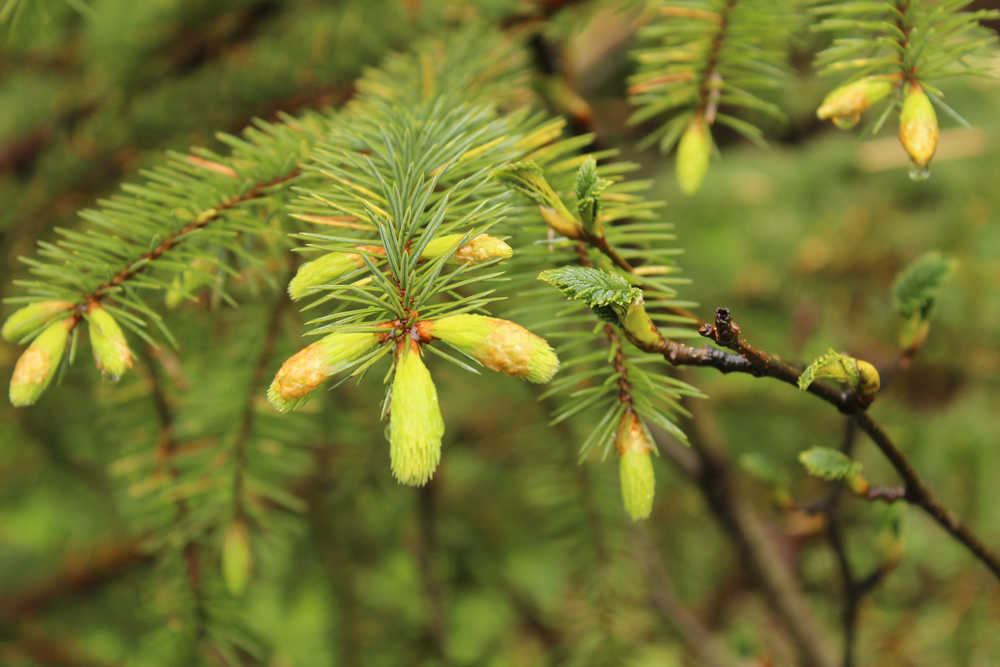Spruce tips are out, and you can use them in jelly, spring tonics, gin and tonics, spruce salt, spruce sugar, spruce bud infused vinegar and pickled spruce buds. Captain Cook, the original maritime health blogger, had his men brew spruce beer to prevent scurvy. Charlie Papazian gives a good recipe for five gallons of spruce tip beer in “The Complete Joy of Home Brewing” which he says tastes a little like Coca Cola, but it’s not bad as it sounds. If you’ve got buds left over the “Forager Chef” blog has a spruce tip ice cream recipe for dessert.
Spruce tip jelly is terrific with venison or hot scones. It has a beautiful golden color and it’s high in vitamin C. You don’t find it in stores so these jars add a nice personal compliment to Christmas packages you send down south. Gathering buds is fast and easy. In most places you can get all you need close to the ground. To speed up picking you can bring a step ladder, make short stilts, stand on the car or whatever.
Pick the new green growth when they are about 1 to 2 inches long. These will be a lighter shade of green than the branch needles and should still be soft and pliable. Giving the branch a good shake before picking will knock off most of the papery brown scales at the end of the bud. You don’t want those.
Buds are out early this year because of the exceptionally mild winter. They’re only ripe for picking a short while. If you put if off, as we all have done, you may be able to push the clock back a week by climbing to a higher elevation, or going to a northern exposure, where the buds come out later. If you don’t have time to make jelly when the buds are out just seal and freeze them for later.
Spruce Tip Jelly
6 cups spruce tips
Rinse in cold water and drain. Cover with water in a big pan and simmer 10 minutes. Some cooks coarse chop the buds before boiling to extract more flavor and nutrients. Let stand overnight. Strain buds through cheese cloth, wring them out, reserving the liquid. That’s your spruce juice. (Wet the cheese cloth first so it doesn’t absorb the juice.) You can work the used buds into the compost heap.
7 cups spruce juice
1 cup lemon juice concentrate
2 packs pectin
7 to 10 cups white sugar
Mix spruce juice, lemon juice and pectin together in a large kettle and heat to rolling boil for 3 minutes. Add sugar all at once. Some recipes call for a 1:1 ratio of spruce juice to sugar. I use 10 cups because it’s the first recipe I tried and it’s never failed. Either way this is a gross amount of sugar. Try not to think about it. Too little sugar may end up as spruce syrup, which is good served warm on ice cream or pancakes, but it’s not jelly. Watch it when you pour in the sugar! Keep the kids back. It’s going to froth up so you will have to stir. Bring back to a boil for 2 minutes, stirring constantly. Test by dropping a few drops into cold water. If they ball up, it’s jelly time. Skim off the foam on top. Ladle the jelly into sterilized jars (half-pint jars work well) cap and seal by processing in a hot water bath.
For people who’ve never canned jelly, the amazing Alaska Cooperative Extension Service has excellent brochures and tutorials online and you can call them with questions. You don’t need a pressure canner. A large pot, a rack, jars, lids and you’re off. Unlike with canning salmon, there’s no botulism to worry about. Follow directions and it’s safe and straight-forward. Store the jars in a cool, dark place. Best to use them within a year but they’re ‘shelf-stable’ as store executives say. A huge batch we made to compare regular lemon juice with Key lime juice (both excellent) lasted over two years.
Right now, right here, one of the largest biological processes on earth is at full throttle. A massive infusion of energy and nutrients is flowing out of the roots, up the trees, down the branches to the farthest ends of the twigs where it consolidates into buds. It doesn’t wait. After about three weeks, start to finish, spruce bud season will be over. On a warm day let your repressed inner hunter/gatherer loose. Grab a friend, pull the kids out of school and pick a few quarts of spruce tips. In this way, we can all hold some spring energy in jars and be a conduit by passing them on to others. ‘We are what we eat,’ as they say. Part of us can be spruce trees.
• Dick Callahan is a Juneau writer. In April 2016, he won first place in the Alaska Press Club Awards for best outdoors or sports column in the state.

